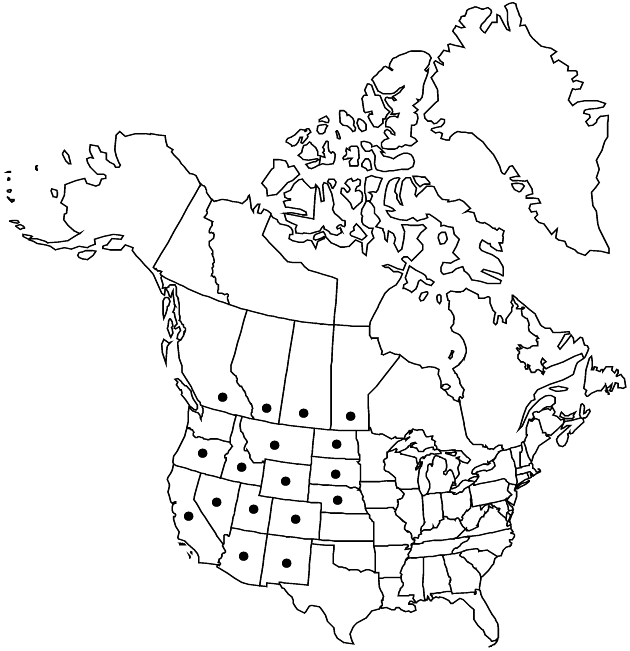Difference between revisions of "Artemisia cana"
Fl. Amer. Sept. 2: 521. 1813.
FNA>Volume Importer |
RevisionBot (talk | contribs) m (Bot: Adding category Revised Since Print) |
||
| (4 intermediate revisions by 3 users not shown) | |||
| Line 6: | Line 6: | ||
|place=2: 521. 1813 | |place=2: 521. 1813 | ||
|year=1813 | |year=1813 | ||
| + | }} | ||
| + | |special_status={{Treatment/ID/Special_status | ||
| + | |code=F | ||
| + | |label=Illustrated | ||
| + | }}{{Treatment/ID/Special_status | ||
| + | |code=E | ||
| + | |label=Endemic | ||
}} | }} | ||
|basionyms= | |basionyms= | ||
| Line 23: | Line 30: | ||
-->{{Treatment/Body | -->{{Treatment/Body | ||
| − | |distribution= | + | |distribution=Alta.;B.C.;Man.;Sask.;Ariz.;Calif.;Colo.;Idaho;Mont.;N.Dak.;N.Mex.;Nebr.;Nev.;Oreg.;S.Dak.;Utah;Wyo. |
|discussion=<p>Subspecies 3 (3 in the flora).</p> | |discussion=<p>Subspecies 3 (3 in the flora).</p> | ||
|tables= | |tables= | ||
| Line 61: | Line 68: | ||
|basionyms= | |basionyms= | ||
|family=Asteraceae | |family=Asteraceae | ||
| − | |distribution= | + | |distribution=Alta.;B.C.;Man.;Sask.;Ariz.;Calif.;Colo.;Idaho;Mont.;N.Dak.;N.Mex.;Nebr.;Nev.;Oreg.;S.Dak.;Utah;Wyo. |
|reference=None | |reference=None | ||
|publication title=Fl. Amer. Sept. | |publication title=Fl. Amer. Sept. | ||
|publication year=1813 | |publication year=1813 | ||
| − | |special status= | + | |special status=Illustrated;Endemic |
| − | |source xml=https:// | + | |source xml=https://bitbucket.org/aafc-mbb/fna-data-curation/src/2e0870ddd59836b60bcf96646a41e87ea5a5943a/coarse_grained_fna_xml/V19-20-21/V19_867.xml |
|tribe=Asteraceae tribe Anthemideae | |tribe=Asteraceae tribe Anthemideae | ||
|genus=Artemisia | |genus=Artemisia | ||
| Line 73: | Line 80: | ||
}}<!-- | }}<!-- | ||
| − | -->[[Category:Treatment]][[Category:Artemisia subg. Tridentatae]] | + | --> |
| + | |||
| + | [[Category:Treatment]] | ||
| + | [[Category:Artemisia subg. Tridentatae]] | ||
| + | [[Category:Revised Since Print]] | ||
Latest revision as of 18:27, 6 November 2020
Shrubs, 50–150 cm (trunks definite, freely branched from bases, branches erect), pleasantly aromatic; root-sprouting. Stems light brown to gray-green (woody, somewhat pliable, leafy), persistently canescent to glabrescent. Leaves deciduous, whitish gray or green to dark gray-green; blades narrowly elliptic to lanceolate, 1.5–8 × 0.2–1 cm, usually entire, sometimes irregularly lobed, sparsely to densely hairy. Heads in (congested, leafy) paniculiform arrays 10–20 × 0.2–7 cm. Involucres (subtended by green, leaflike bracts) narrowly to broadly campanulate, 3–4 × 2–5 mm. Phyllaries ovate or lanceolate (scarious margins nearly invisible), densely canescent. Florets 4–20; corollas 2–3 mm, resinous (style branches ellipsoid, to 2.3 mm, exsert, gland-dotted). Cypselae (light brown) 1–2.3 mm, resinous.
Distribution

Alta., B.C., Man., Sask., Ariz., Calif., Colo., Idaho, Mont., N.Dak., N.Mex., Nebr., Nev., Oreg., S.Dak., Utah, Wyo.
Discussion
Subspecies 3 (3 in the flora).
Selected References
None.
Lower Taxa
Key
| 1 | Shrubs 100–150 cm; leaves 2–8 cm (entire); primarily e of continental divide | Artemisia cana subsp. cana |
| 1 | Shrubs 50–90 cm; leaves 1.5–4 cm (usually some with irregular lobes); w of continental divide | > 2 |
| 2 | Stems felty-tomentose; leaves green to gray-green; involucres 4–5 mm diam.; California, Nevada, Oregon | Artemisia cana subsp. bolanderi |
| 2 | Stems hairy (not felty-tomentose); leaves green to dark green; involucres 2–3(–4) mm diam.; Arizona, Colorado, Idaho, Montana, Nevada, New Mexico, Utah, Wyoming | Artemisia cana subsp. viscidula |